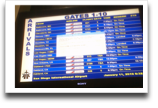One of the things I enjoy about going to Macworld Expo is finding something I didn’t know I needed. A few weeks back, I was diagnosed with tendonitis in my right arm. I’ve been wearing a brace on it and trying to do some exercises to help it. At Macworld Expo, I stumbled upon a booth for an ergonomic mouse.
I’m not a huge mouse person as I have been using trackballs for many years. However, I listened to the HandShoeMouse pitch, put my hand on a mouse and within minutes, I bought one. This mouse was not cheap (it cost $89 which apparently is a $40 savings), but how much is my health worth? I use a computer all day long and if I have pain, it will seriously impact my ability to earn money, so it is a small investment.
I’ve been using the mouse for about 2 weeks now and am pretty used to it by now. The only quirk I’ve had is that it goes to sleep and you have to press a button on the mouse to wake it up. The developers of this mouse have really put a lot of time and thought into it. It has a rechargable battery that recharges via USB when it gets low; and the light on the scrollwheel lights up when you need it to recharge. They were also very insisitent that they didn’t want it to have any drivers which sold me even more; plug and play.
Time will only tell if this mouse will help me, but it is definitely worth looking at if you use a computer for long periods of time which these days is just about everyone I know.
Pros
- Glides smoothly on my desk.
- Very comfortable.
- Wireless.
- Very accurate tracking (I got the BluRay Track version.
- May prove to help with RSI.
Cons
- High cost.
- Feels weird using a mouse having used a trackball for many years.
- Scroll wheel sometimes feels like it is slipping.
- Takes a second or two to wake when it has gone to sleep; you have to wake it by pressing a button as moving it does nothing.
Summary
I’m pretty pleased with this purchase and am hopeful that it will help with my current injury and help prevent future ones. I still need to look into getting a very smooth mousepad as my desk is a little rough and I’d like a bit less friction when moving the mouse; maybe they could have included one, but I guess mousepads are a dime a dozen these days (maybe not the real smooth ones).
